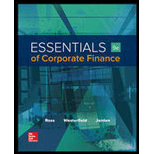
EBIT, Taxes, and Leverage. Repeat parts (a) and (b) in Problem 1 assuming the company has a tax rate of 35 percent.
a)
To calculate: The EPS (Earnings per share) under the three scenarios before the debt issue and the changes in EPS while the economy expands a recession
Introduction:
The EPS is the part of the profit of a firm that is allocated to every outstanding share of common stock. It indicates the profitability of the company.
Answer to Problem 2QP
The EPS under the recession, normal, and expansion periods are $0.79, $1.22, and $1.46 respectively and the percentage of change in EPS is -35% and +20% for the recession and expansion periods respectively.
Explanation of Solution
Given information:
Company K has no debt outstanding and its market value is $194,775. EBIT (Earnings before interest and taxes) are expected to be $13,800 under normal economic conditions. If the economy condition is strong, then EBIT will increase to 20% and if the economy enters into recession, then it will decrease to 35%. The outstanding shares are $7,350. The rate of tax is 35%.
Formula to calculate taxes:
Compute taxes for three periods:
Hence, the tax during recession is $3,140.
Hence, the tax during normal period is $4,830.
Hence, the tax during expansion is $5,796.
Formula to calculate the NI (Net Income):
Compute NI for three periods:
Hence, the net income during recession is $5,831.
Hence, the net income during normal period is $8,970.
Hence, the net income during expansion period is $10,764.
Formula to calculate EPS:
Compute EPS:
Hence, EPS during recession period is $0.79.
Hence, EPS during normal period is $1.22.
Hence, EPS during expansion period is $1.46.
Table showing the income statement for the three possible periods of economy with the EPS and percentage change in EPS:
| Recession | Normal | Expansion | |
| EBIT | $8,970 | $13,800 | $16,560 |
| Interest | 0 | 0 | 0 |
| Taxes | $3,140 | $4,830 | $5,796 |
| NI | $5,831 | $8,970 | $10,764 |
| EPS | $0.79 | $1.22 | $1.46 |
| %ΔEPS | –35% | NIL | 20% |
Note:
According to the given information, during the recession period, the EBIT will decrease to 35% and during the expansion period, EBIT will increase to 25%.
b)
To calculate: EPS (Earnings per share) under the three scenarios before the debt issue and the changes in EPS while the economy expands a recession by assuming that the firm undergoes the planned recapitalization
Introduction:
The EPS is the part of the profit of a firm that is allocated to every outstanding share of common stock. It indicates the profitability of the company.
Answer to Problem 2QP
After recapitalization, the EPS under the recession, normal, and expansion periods are $0.73, $1.27, and $1.58 respectively and the percentage of change in EPS is -42.31% and +24.18% for the recession and expansion periods respectively.
Explanation of Solution
Given information:
The company is considering the debt issue of $39,750 with the rate of interest at 6%. At present, the outstanding shares of $7,350 exist.
Formula to calculate the share price:
Compute the share price:
Hence, the price of the share is $26.5.
Formula to calculate the repurchased shares:
Compute the repurchased shares:
Hence, the repurchased shares are $1,500.
Formula to calculate the payment of interest:
Compute the payment of interest:
Hence, the payment of interest is $2,385.
Formula to calculate the NI (Net Income):
Compute NI for three periods:
Hence, the net income during recession is $4,280.
Hence, the net income during normal period is $7,420.
Hence, the net income during expansion period is $9,214.
Formula to calculate EPS:
Compute EPS:
Hence, the EPS at recession period is $0.73.
Hence, the EPS at normal period is $1.27.
Hence, the EPS at expansion period is $1.58.
Note: After recapitalization, $1,500 was recovered from the total outstanding shares of $7,350. Now, the shares outstanding is $7,350-$1,500=$5,850.
Formula to calculate the percentage change in EPS:
Compute the percentage change in EPS for recession period:
Hence, the percentage change in EPS for recession period is -$42.31%.
Compute the percentage change in EPS for expansion period:
Hence, the percentage change is EPS for expansion period is 24.18.
Table showing the income statement for the three possible periods of economy under the planned recapitalization with EPS and percentage change in EPS:
| Recession | Normal | Expansion | |
| EBIT | $8,970 | $13,800 | $16,560 |
| Interest | $2385 | $2385 | $2385 |
| Taxes | $2,305 | $3,995 | $4,961 |
| NI | $4,280 | $7,420 | $9,214 |
| EPS | $0.73 | $1.27 | $1.58 |
| %ΔEPS | –42.31% | NIL | 24.18% |
Want to see more full solutions like this?
Chapter 13 Solutions
ESSENTIALS CORPORATE FINANCE + CNCT A.
- Please help me answer questions 7-1 and 7-2arrow_forwardfind the balance after 7years if $55000 is invested at 6% p.a. compound annuallyarrow_forwardHow does risk-adjusted return, such as the Sharpe Ratio, influence portfolio selection beyond just expected return? Please provide a referencearrow_forward
 Financial Accounting: The Impact on Decision Make...AccountingISBN:9781305654174Author:Gary A. Porter, Curtis L. NortonPublisher:Cengage Learning
Financial Accounting: The Impact on Decision Make...AccountingISBN:9781305654174Author:Gary A. Porter, Curtis L. NortonPublisher:Cengage Learning Cornerstones of Financial AccountingAccountingISBN:9781337690881Author:Jay Rich, Jeff JonesPublisher:Cengage Learning
Cornerstones of Financial AccountingAccountingISBN:9781337690881Author:Jay Rich, Jeff JonesPublisher:Cengage Learning


